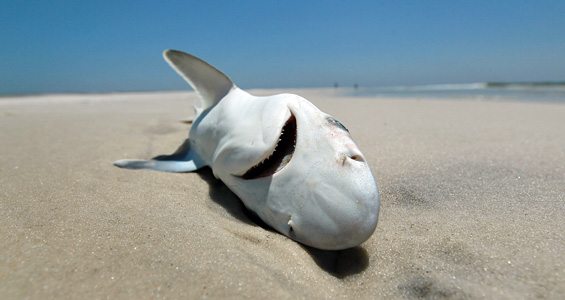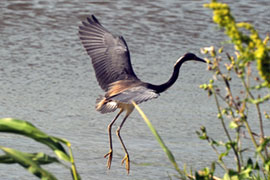US oil spill threatens wildlife
The oil leak in the US Gulf of Mexico could cause major damage to wildlife.

 |
| Toxic from the oil could kill and sicken sharks and other marine species [AFP] |
A huge oil spill from a sunken offshore rig in the US Gulf of Mexico is threatening marine life and could cause widescale damage along the coast of the Gulf of Mexico.
Oil has already begun to wash ashore in the Mississippi river delta, a biologically significant region, comprising 12,000 sq km of coastal wetlands teeming with wildlife.
Keep reading
list of 4 itemsAfter the Hurricane
World’s coral reefs face global bleaching crisis
Why is Germany maintaining economic ties with China?
Cynthia Sarthou, the executive director of the Gulf Restoration Network, told Al Jazeera that this is the “worst time” an oil spill could hit the area.
“Many marine species, fish and wildlife are now breeding. A lot of birds are nesting, their young are hatching,” she said.
“An entire breeding season is potentially going to be lost.”
Food contamination
Sarthou also said there was a significant potential danger to mammals who have to go to the water’s surface to breath.
“There are a lot of dolphins out there … There are sperm whales in the area where the rig sank,” she said.
| in depth | |||||||||||||||||||||||||||||
|
“They are diving and feeding there, so there’s a potential for both ingestion of contaminated food sources and skin contamination from the oil that they’ll be swimming through.”
The National Oceanic and Atmospheric Administration (NOAA) said that whales could starve to death if the oil clogs the baleen, the filter inside their mouth through which they feed.
The toxins from oil sinking below the surface can kill marine mammals, fish and aquatic invertebrates and can also cause liver disease, cancer and reproductive impairment, the NAOO said on its website.
“As long as that oil is there it’s going to prevent the foundation of the food chain from living and thriving,” LuAnn White, director of Tulane University’s Centre for Applied Environmental Public Health, said.
The northern Gulf of Mexico is a crucial spawning ground in springtime for the critically endangered bluefin tuna.
Their eggs float, and the larvae after they hatch, float near the surface making them vulnerable to pollutants sitting on the water.
“We expect a spill like this could dramatically decrease the amount of bluefin tuna larvae that are surviving,” John Hocevar, the Oceans Campaign director for Greenpeace USA, said.
Suffocation risk
Several species of turtles, all threatened or endangered, reside in the Gulf and are in the peak of their nesting season, while areas important to bird populations were among those likely to be affected.
 |
| Several areas important to bird populations were likely to be affected [AFP] |
The oil could affect the bird’s food sources and destroy areas where they are nesting.
They could also suffocate or die of hypothermia if their feathers are covered with oil.
According to the National Audubon Society, places it designates as “Important Bird Areas” or IBAs could be at risk, including Chandeleur Islands IBA and Gulf Islands National Seashore IBA in Louisiana and Mississippi.
In Florida, Audubon is recruiting volunteers and making its Centre for Birds of Prey available for bird cleansing and rehabilitation.
Species particularly at risk include the brown pelican, which was only removed from the US Endangered Species Act last year, as well as beach-nesting terns and gulls.
Eroding wetlands
The Mississippi delta is home to 40 per cent of wetlands in the United States.
“It’s not like a bunch of volunteers can go down and mop up the beach,” LuAnn White, director of Tulane University’s Centre for Applied Environmental Public Health, said.
| Mississippi delta | |||||
|
“There are just miles and miles of coastal wetlands there that can only be reached by boat. And they’re very delicate.”
The oil could accelerate the erosion of the sensitive coastal wetlands, which is already taking place at a rate equivalent to 30 football fields a day due to wave activity and storms.
Tom Minello, an ecologist with NOAA, warned that the impact was likely to be long-term.
“If you get direct oiling of intertidal salt marshes and sea grass beds it’ll just kill the vegetation,” he said.
“It takes years for a wetland to recover from that kind of oiling.”
“You wouldn’t want this to happen anywhere but in this particular location there’s a real potential for long-term problems.”

